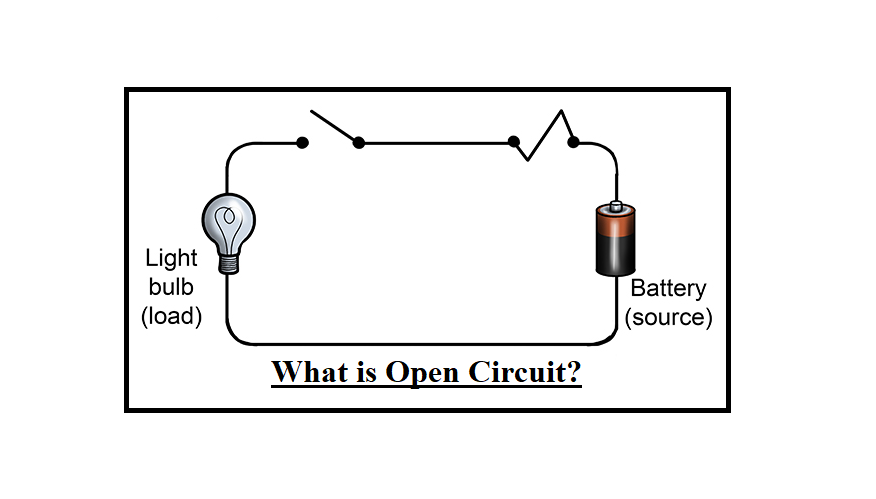An open circuit is one in which the path has been broken or “opened” at some point, preventing current from flowing. An open circuit is also known as an incomplete circuit. An open circuit might be either intentional or unintentional. The circuit to the room’s turned-off lights would be an intentionally open circuit. Because the switch is in the “off” position, which “opens” the path via which power would ordinarily flow, there is no closed path available for energy to flow to the lights.
An open circuit is an electric circuit that does not allow current to pass. In a circuit, current can only flow if it finds a continuous path—this is known as a “closed circuit.” The issue of an open circuit is crucial when employing Electrical Devices in industrial applications. Open Circuit solutions are provided by several Suppliers and Companies, different manufacturers, and a lot of distributors.
There is a complete list of Open Circuit services on the Linquip website that covers all of your needs. Linquip can connect you with a number of Open Circuit and Electrical service providers and experts who can help you. Linquip provides a list of Open Circuit and Subject Matter Experts who can help you with equipment testing.
When a circuit breaker operates owing to too much current on the circuit and switches it off, this is an example of an unintentionally open circuit. The circuit breaker or fuse “opened” or “tripped” the circuit, according to standard electrical industry terminology. This was accomplished by “opening” the circuit breaker’s switch.
What is an Open Circuit?
An open circuit is an electric circuit that does not allow current to pass. In a circuit, current can only flow if it finds a continuous path—this is referred to as a “closed circuit.” You have an open circuit if there is a break anywhere in the circuit, and current cannot flow.
The two terminals are disconnected in an open circuit. As a result, the circuit’s continuity is interrupted. Even though the current cannot flow through the circuit, there is a voltage drop between two points. As a result, in an open circuit, the current flowing through it is zero, but voltage is present (non-zero). The current is now zero, and the power is equal to VI. As a result, power is also zero, and no power is dissipated by an open circuit.
To get electric current to flow, you need a closed path or closed circuit. You get an open circuit if there is a break in the channel, and the current stops flowing — and the metal atoms in the wire rapidly settle down to a peaceful, electrically neutral state.
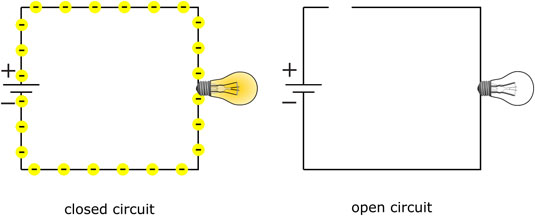
Current can flow in a closed circuit, while electrons are left stranded in an open circuit. Consider the flow of a gallon of water via an open pipe. When all of the water has exited the pipe, the water will flow for a short time before stopping. If you pump water to flow across a closed pipe system, it will continue to do so as long as you keep forcing it to. Visit here to see the principle of the open circuit.
By design, open circuits are frequently generated. A simple light switch, for example, opens and shuts the circuit connecting a light to a power source. When you’re building a circuit, it’s a good idea to turn off the battery or other power source when you’re not using it. In technical terms, you’ve made an open circuit.
An open circuit is a flashlight that has been turned off. The flat black button in the lower left of the flashlight is the controller of the switch inside. The switch is nothing more than two flexible metal pieces placed close together. The switch is open and the flashlight is off when the black button is slid all the way to the right.
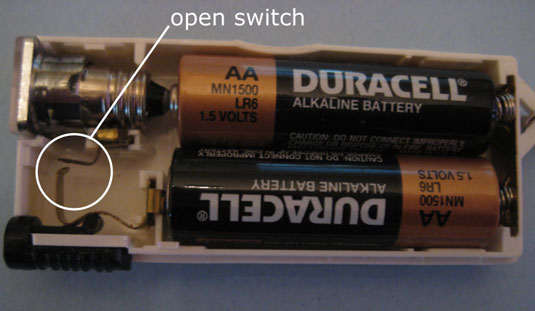
By sliding the black button to the left to turn on the flashlight, the two pieces of metal are pushed together — or the switch is closed — and the circuit is completed, allowing current to flow.

Unintentional Open Circuit
Open circuits may sometimes be unintentionally produced. For example, you might forget to attach a battery or have a wire break anywhere in your circuit. When using a solderless breadboard to design a circuit, you may accidentally insert one side of a component into the wrong hole, leaving that component disconnected and generating an open circuit. Accidental open circuits are normally safe, but they can cause a lot of irritation when you’re trying to figure out why your circuit isn’t operating properly.
Short circuits, on the other hand, are a different story. A short circuit occurs when two points in a circuit that aren’t supposed to be linked, such as the two terminals of a power source, are linked directly. Because electric current follows the path of least resistance, it will avoid other parallel channels in a short circuit and proceed through the direct link. (Imagine the current being lazy and taking the path that requires the least amount of effort)
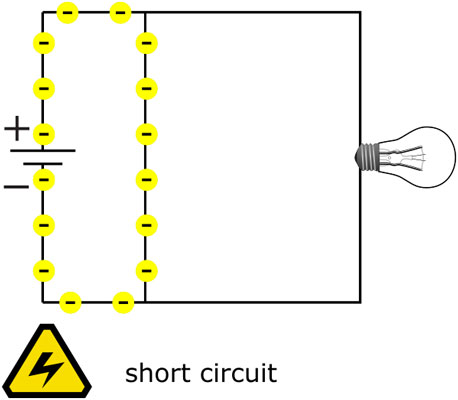
What Causes an Open circuit?
Component Failure
Component failure occurs when one or more of the circuit’s components fails or is damaged. For example, suppose you have three resistors R1, R2, and R3 connected in a circuit. R2 is burnt out due to a variety of factors. Because there is an open circuit, the circuit is no longer complete.
Break in Conductor
A conductor break can occur for a variety of reasons. Because of aging or wear and tear, conductors can break. It is possible for a conductor to break by accident or on purpose. There are numerous causes for this, and you can identify them all.
Manual Interruption
We just experienced a manual interruption. We can do this simply by turning off the light. We can also use the circuit breaker as an example. When we manually open a circuit breaker for maintenance, we are generating an open circuit.
Open circuit can have different impacts on parallel and series circuits by its resistance variation. The open circuit resistance is discussed in more detail below.
Open Circuit Resistance
An open circuit means that the two terminals or points are disconnected externally, which is comparable to a resistance of R=∞. This means that regardless of the voltage difference, no current can pass between the two terminals. (Note that even over huge air or vacuum gaps, very high voltages can create current arcs!)
Ohm’s law describes the behavior of a resistor. The current is proportional to the voltage across the resistor. The ohm’s law equation is:
V=IR \Rightarrow R=\frac{V}{I}
The current is zero (I = 0) in an open circuit condition (If R= V/0, then R=∞). As a result, in open circuit situations, the resistance is infinite for any voltage value.
Open Circuit vs Short Circuit
Open circuit and short circuit are two specific topologies in electrical engineering that have opposite characteristics. Both designs depict the connection of two circuit terminals. So, what’s the difference between an open circuit and a short circuit, exactly?
The current flowing through the circuit is zero while the circuit is open. In the case of a short circuit, the current flowing through the circuit is extremely high (infinite). In open circuits, the resistance between two terminals is unlimited. In short circuits, the resistance between two terminals should be zero. However, there is relatively little resistance in practice.
The voltage across the open circuit’s terminals is the same as the supply voltage. The voltage across the short circuit terminals is zero in a short circuit.
When a circuit is operating normally and the current is flowing through the components, it is said to be in a closed circuit. Only when a close path is built, the current can flow. A current will flow from the negative to the positive polarity of the voltage in a close path. The following diagram depicts the differences between a closed circuit, an open circuit, and a short circuit.
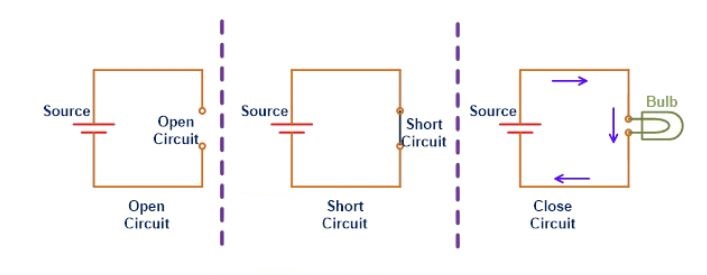
Open Circuit Example
In most situations, an open circuit is caused by a conductor breaking. The current cannot flow if the circuit is not closed and there is a break at any place in the loop. This results in an open circuit. Consider a bulb that is powered by a battery and controlled by a switch. The circuit diagram is given in the figure below.

When a switch is turned on, it interrupts a path. It signifies that in this situation, the current cannot flow. This is known as an open circuit state. When you close a switch, it creates a closed path. Also, some current will pass through the load (such as a bulb). This is a closed circuit or normal condition. If the positive and negative terminals of a battery are connected, the current has a close channel to pass regardless of the conditions. However, there is no load (resistance). As a result, there is a short circuit and a lot of electricity flowing.
What Is an Open Circuit for Class 6?
The bulb does not light up if there is any gap in the course of the circuit. An open circuit is exactly what it sounds like. Closed-circuit: When a bulb and wire make a full path that starts at one terminal of an electric cell and finishes at the other terminal, the bulb will light up.
Is Open Circuit Dangerous?
Fuse is a term that you must be familiar with. In an unusual situation, a fuse can also be utilized to generate an open circuit. As a result, the circuit or a specific piece of equipment is preserved. The fuse will be blown and the current will be cut whenever an abnormally high current passes through the circuit. As a result, the equipment and the circuit will be saved. In this case, the fuse is actually creating an open circuit. So, is open circuit beneficial? Yes, it is beneficial in certain instances, but not all.
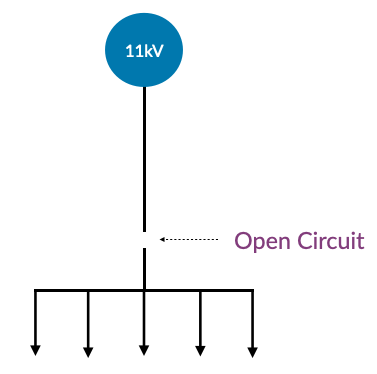
Suppose we have an 11kV system like the one illustrated. We are transmitting power via cables. The cable has been broken by accident. As a result, the system now has an open circuit. Across the break, the complete voltage will now be available. If the voltage is high enough, an arc will form between the two breaks, so this can result in considerable power loss and, in the worst-case scenario, a system destruction. Of course, this will not happen at low voltages, but it can occur at high voltages. As a result, open circuit is not always a good thing, and it can also be dangerous.
Summary
Let’s summarize this post here:
- An open circuit is one in which the flow of electrons has been disrupted by a break in the path.
- An open circuit can occur as a result of a component failure, a conductor break, or a manual interruption.
- An open circuit in a series circuit can result in a full loss of current.
- Only the branch impacted by the open circuit will have zero current in a parallel circuit.
- An arc can also be caused by an open circuit.
Download Open Circuit PDF
Buy Equipment or Ask for a Service
By using Linquip RFQ Service, you can expect to receive quotations from various suppliers across multiple industries and regions.
Click Here to Request a Quotation From Suppliers and Service Providers
Read More In Linquip
- Types of Electric Circuits: All Classification with Application
- How does a Circuit Breaker Work?
- What is Resistive Circuit
- What is Linear Circuit
- What is RL Circuit
- What is RC Circuit?
- What is RLC Circuit
- What is Capacitive Circuit?
- Types of Resistor: Classification, Application, and Finally Clarification
- What is Parallel Circuit? Definition & Example
- What is Series Circuit? Definition & Example
- What is Closed Circuit? Definition & Example
- What is Short Circuit? A Clear Definition & Protection Guide
- Difference Between Linear and Nonlinear Circuits
- What are the Differences Between Series and Parallel Circuits?
- The 8 Best Circuit Breaker Locators

